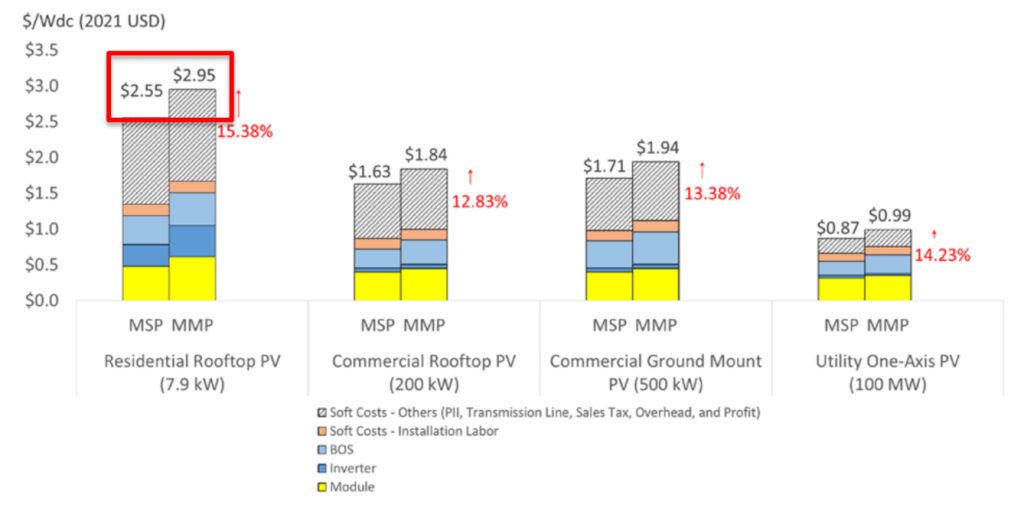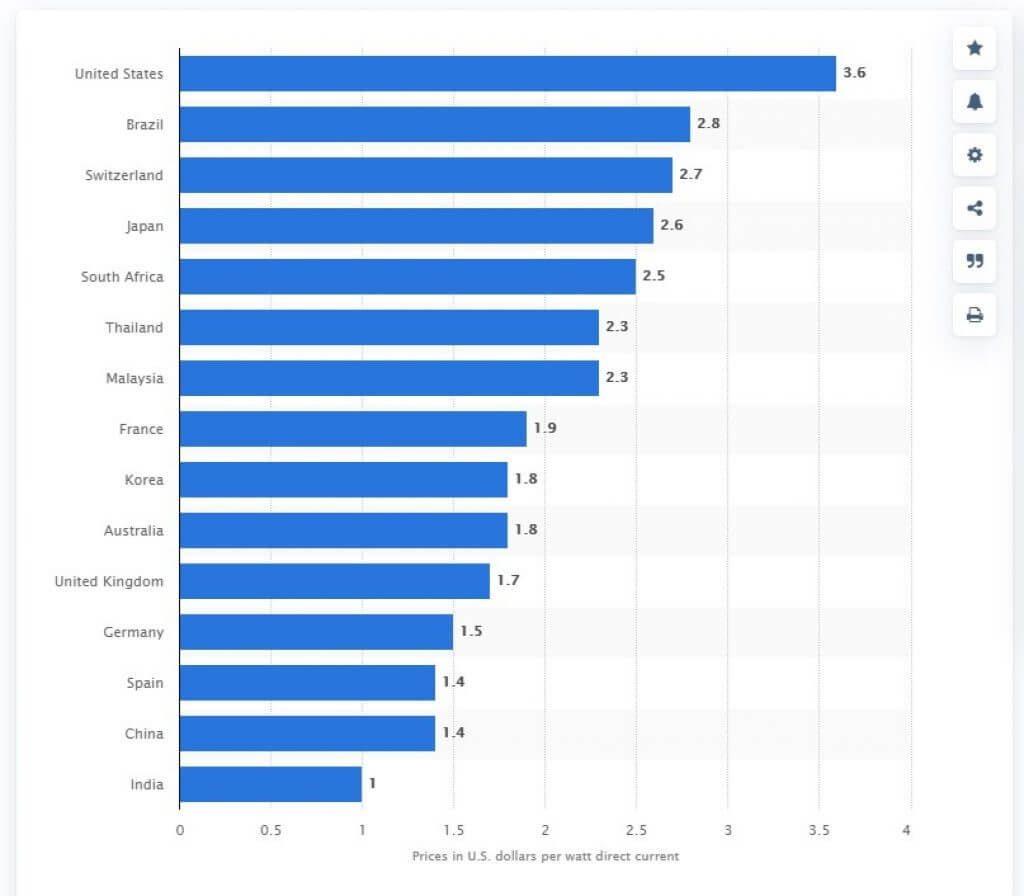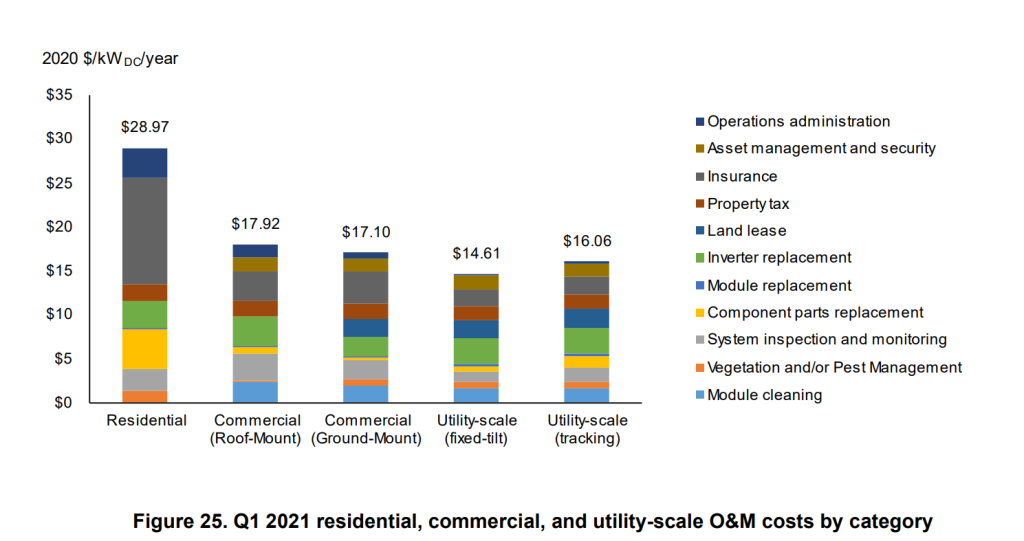10kW solar systems are becoming increasingly popular throughout the U.S. These systems are perfect for households with a slightly above-average amount of electricity. This raises the question, how much does a 10kW solar system cost?
Sure, you can spend your precious free time figuring out a rough estimate by gathering multiple solar quotes, but the tedious nature of the process will likely put you off.
For this reason, we did some digging to show you how much a 10kW solar system costs.
Moreover, we discuss the factors that influence the price of such a system, how much you’ll need to spend on maintenance, and more.
Table of Contents
How much does a 10kW solar system cost?
The below table illustrates the cost of a 10kW solar system in the following states:
| State | Cost (USD) | After-Tax Incentives* (30%) |
|---|---|---|
| Colorado | $28,200 – $34,400 | $19,740 – $24,080 |
| Massachusetts | $27,500 – $34,700 | $19,250 – $24,290 |
| New York | $27,100 – $36,100 | $18,970 – $25,270 |
| Maryland | $25,100 – $33,300 | $17,570 – $23,310 |
| New Jersey | $24,000 – $31,800 | $16,800 – $22,260 |
| California | $24,000 – $29,800 | $16,800 – $20,860 |
| Washington | $23,100 – $29,700 | $16,170 – $20,790 |
| Texas | $22,700 – $30,100 | $15,890 – $21,070 |
| Florida | $21,400 – $27,400 | $14,980 – $19,180 |
Source: Energy Sage.
* subject to eligibility to claim the federal solar tax credit.
Before you click away, understand that these market prices are near-term figures based on supply, demand, supply chain, geopolitical issues (tariff war, tensions between countries), etc.
In uncertain market environments, these Reported Market Prices (RMP) can be volatile and inaccurate.
For this reason, it’s always a good idea to take these online cost-comparing websites with a grain of salt. Not to mention, there are always soft costs involved in operating an e-commerce business.
Thankfully, we found a theoretical methodology courtesy of the National Renewable Energy Laboratory (NREL).
Minimum sustainable price (MSP) and modeled market price (MMP) benchmark for 10kW solar system
The NREL’s report modeled the Minimum Sustainable Price (MSP) for installing residential solar.
This methodology looks at the solar cost modeling from a long-term analysis by removing short-term impacts of recent:
- Solar market environments.
- Global and geopolitical events.
- Location-specific federal policies.
However, the downside of solely relying on this method is that you end up with impractical price points.
NREL acknowledges the dilemma of choosing between purely empirical and theoretical pricing methodologies. They also devised a Modeled Market Price (MMP) benchmark for solar.

Therefore, as per NREL MSP and MMP benchmarks, the cost of a typical 10kW solar system in the U.S. falls between $25,500-$29,500, respectively, while online quotations range between $21,400-$34,400, depending on which state you live in.
What factors determine the cost of a 10kW solar system?
The cost of a 10kW solar system is influenced by its:
- Physical assets.
- Soft costs.
Physical assets
Hardware and infrastructure costs are expenditures related to physical assets you procure and assemble when building a PV system.
There are three main categories: PV panels and inverters, BOS, and energy storage.
- Balance of solar PV systems (BOS): BOS refers to all PV system components except solar panels, energy storage, and inverters. These are your PV rails, charge controllers, mounts, cables, fuses, conduits, protection systems, grounding, etc.
- Module and inverter: These are your PV panels and inverters that convert the DC solar output to the AC power your household devices require.
- Energy storage (optional): Energy storage is an additional component. This allows you to store solar energy for later use or during emergencies.

Soft costs
Non-hardware costs (also known as soft costs) are the intangible aspects of a PV system. These costs are associated with solar system financing, design, engineering, legal work, and business margins.
Engineering, design, civil, and architectural work
Big projects such as a 10kW PV system are made with the help of professionals from disciplines working together. Hiring the expertise of solar developers gives you the following services:
- Cell architecture design.
- Assessment of the installation area.
- Supervised manual labor.
- Infrastructure erection.
- Utility compliance.
- Solar system commissioning.
Overhead and profit
Business owners rely on gross sales and margins to keep their operations going. Profit and the net cost of making and installing solar panels are added to the price of a 10kW solar system.
Cost of customer acquisition
Arguably, we can include this item under overhead and profit. However, we think it deserves to be a separate category given its high share of the solar installation cost (see the dark gray area enclosed in the red box below).

Source: NREL 2021 report.
The cost of borrowing money
Borrowing money comes at a price. Those of you who follow the latest finance news will be aware of this. Always be mindful of this during any significant undertaking.
How location affects a 10kW solar system’s cost
Only some people are aware of this, but policy and location-specific practices are also underlying factors that significantly affect the cost of a 10kW solar system.
The chart below illustrates the differences in residential solar installation prices per country.
Some of you may have noticed that the U.S. is the most expensive place to install residential solar. We found that this is due to the following:
- High competition among installers leads to higher customer acquisition costs.
- City-level permitting.
- Other local regulatory processes.

However, some solar incentive programs dampen the price of 10kW solar systems. The U.S. Department of Energy recently announced that it would extend the solar tax incentives for another decade and raise the tax credit back to 30%.
We suggest looking up solar programs sponsored by your state. Some examples are the California Solar Initiative (CSI) and Net Energy Metering Program (NEM), which aim to make solar affordable.
How much does a 10kW solar system cost to maintain?
NREL’s Benchmark P.V. operation and maintenance (O&M) costs for residential are estimated at $28.97/kW/yr. Therefore, a 10kW solar system requires $289.7/year for O&M.
This estimate considers 2020 labor rates, replacement costs, discount rate, inflation rate, capital expenditures, module power and efficiency, degradation rates, warranty period, and cost of aerial inspection adjusted for the 2021 fiscal year.

Source: NREL Report.
Will a 10kW solar system become cheaper?
Will a 10kW solar system become cheaper in the future?
We used to believe that solar costs have no way to go but down. With green energy innovations and supportive policies coming in from all directions, solar energy should ideally be accessible to all.
However, in light of the recent global events, there might be some exceptions. Inflation, geopolitical events, and financial policies significantly impact the cost of solar systems.
Therefore, even though expert findings say that the cost of making solar is getting cheaper, the price might vary due to current circumstances.
Related reading: BougeRV 200W 12V 9-Busbar Solar Panel Review
Final thoughts
The thing about quotations and theoretical studies about 10kW solar system cost is that they are based on assumptions. Here are some choices that affect 10kW solar system cost
- Will you fully pay the 10kW system in cash or through financing?
- Micro inverter or string inverters?
- Regular roof mount or ground mount with the solar tracker?
- Good-looking Tesla solar roof or cheaper alternatives?
- Don’t even get us started on solar panel cell architecture and efficiencies.
In real life, each client will have different circumstances requiring professional guidance. Don’t let this discourage you. It shows that investing in solar is a big undertaking, but it will be worth it if you do it right.
Some of you might be overwhelmed by the open-ended questions and realizations we introduced today. It is a valid feeling. Yet, from our perspective, we think that giving you the basics of 10kW solar system cost while giving an introduction to advanced concepts will help you think deeper about how to look at solar energy and decarbonization.
Indeed, green energy and climate change technology is full of diverse topics and rabbit holes. We hope that some of them piqued your interest.

